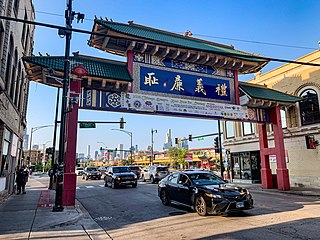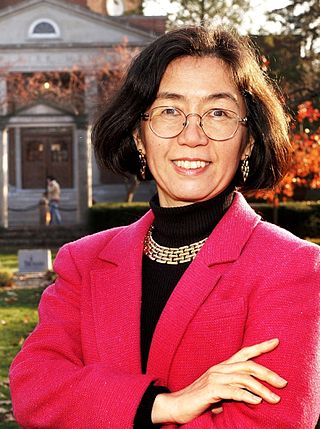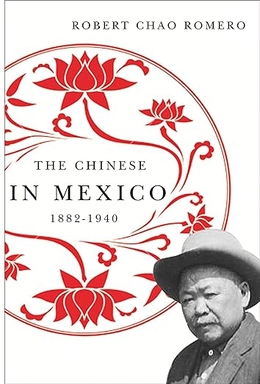Related Research Articles

A tong is a type of organization found among Chinese immigrants predominantly living in the United States, with smaller numbers in Canada, Australia, and the United Kingdom. In Chinese, the word tong means "hall" or "gathering place". These organizations are described as secret societies or sworn brotherhoods and are often tied to criminal activity. In the 1990s, in most American Chinatowns, clearly marked tong halls could easily be found, many of which have had affiliations with Chinese organized crime.

Taishan, alternately romanized in Cantonese as Toishan or Toisan, in local dialect as Hoisan, and formerly known as Xinning or Sunning (新寧), is a county-level city in the southwest of Guangdong province, China. It is administered as part of the prefecture-level city of Jiangmen. During the 2020 census, there were 907,354 inhabitants, but only 433,266 were considered urban. Taishan calls itself the "First Home of the Overseas Chinese". An estimated half a million Chinese Americans are of Taishanese descent.

Chinatown is a neighborhood on the South Side of Chicago, along S. Wentworth Avenue between Cermak Road and W. 26th St. Over a third of Chicago's Chinese population resides in this ethnic enclave, making it one of the largest concentrations of Chinese-Americans in the United States. It formed around 1912, after settlers moved south from near the Loop, where the first enclaves were established in the 19th century.

Pu Songling was a Chinese writer during the Qing dynasty, best known as the author of Strange Tales from a Chinese Studio.
Transnationalism is a research field and social phenomenon grown out of the heightened interconnectivity between people and the receding economic and social significance of boundaries among nation states.

Gold Mountain is a historical name for either San Francisco, the State of California, or broadly the western regions of North America, including British Columbia, Canada. After gold was found in the Sierra Nevada in 1848, thousands of Cantonese from Toisan City in Guangdong Province began to migrate to California in search of gold and riches during the California Gold Rush.

The history of Chinese Americans or the history of ethnic Chinese in the United States includes three major waves of Chinese immigration to the United States, beginning in the 19th century. Chinese immigrants in the 19th century worked in the California Gold Rush of the 1850s and the Central Pacific Railroad in the 1860s. They also worked as laborers in Western mines. They suffered racial discrimination at every level of White society. Many Americans were stirred to anger by the "Yellow Peril" rhetoric. Despite provisions for equal treatment of Chinese immigrants in the 1868 Burlingame Treaty between the U.S. and China, political and labor organizations rallied against "cheap Chinese labor".

AsianWeek was America's first and largest English-language print and on-line publication serving East Asian Americans. The news organization played an important role nationally and in the San Francisco Bay Area as the “Voice of Asian America”. It provided news coverage across all East Asian ethnicities.

Huping Ling is a Chinese American academic. She is a professor of history and past department chair at Truman State University in Kirksville, Missouri, where she founded the Asian studies program. She is the recipient of the Lifetime Achievement Award 2024 by the Association for Asian American Studies. She is the Visiting Fellow of the Hoover Institution at Stanford University, the Changjiang Scholar Chair Professor of the Chinese Ministry of Education, Distinguished Honorary Professor at Lishui University, and a Visiting Professor of the Institute of Overseas Chinese Studies at Jinan University. She is the funding and inaugural book series editor Asian American Studies Today for Rutgers University Press, on the Editorial Board of Overseas Chinese History Study, the Overseas Chinese History Research Institution, Beijing, China, and served as the Executive Editor-in-Chief for the Journal of Asian American Studies. She is also on the Board of Directors of the Chinese Historical Society of Overseas Chinese Studies, the editorial board of Overseas Chinese History Studies, and serves as a consultant to the Overseas Chinese Affairs Office of Guangdong Provincial Government.

Chinatown in St. Louis, Missouri, was a Chinatown near Downtown St. Louis that existed from 1869 until its demolition for Busch Memorial Stadium in 1966. Also called Hop Alley, it was bounded by Seventh, Tenth, Walnut and Chestnut streets.

The Sichuanese people are a Han Chinese subgroup comprising most of the population of China's Sichuan province and the Chongqing municipality.

The New York metropolitan area is home to the largest and most prominent ethnic Chinese population outside of Asia, hosting Chinese populations representing all 34 provincial-level administrative units of China. The Chinese American population of the New York City metropolitan area was an estimated 893,697 as of 2017, constituting the largest and most prominent metropolitan Asian national diaspora outside Asia. New York City itself contains by far the highest ethnic Chinese population of any individual city outside Asia, estimated at 628,763 as of 2017.
The Chicago metropolitan area has an ethnic Chinese population. While historically small in comparison to populations on the coasts, the community is rapidly expanding. As of 2023, there are 78,547 Chinese Americans who live in Chicago, comprising 2.9% of the city's population, along with over 150,000 Chinese in the greater Chicago area - making Chicago's Chinese community the 8th largest among US metropolitan areas. This population includes native-born Chinese as well as immigrants from Mainland China, Taiwan, Hong Kong and Southeast Asia, and also racially mixed Chinese.
Greater St. Louis has a Chinese community.

The Chinese in Mexico, 1882–1940 is a 2010 book by Robert Chao Romero, published by the University of Arizona Press, about the history of Chinese immigration to Mexico. This is the first English-language monograph written about Chinese immigration to Mexico. Anju Reejhsinghani of University of Wisconsin-Stevens Point described it as "a social history of the small but influential Chinese merchant and laboring community in northern Mexico in the first half of the twentieth century." Erika Lee of the University of Minnesota stated that because much of the existing literature on Asian immigration to North and South America discusses the United States, this book "fills an enormous historiographical gap."
Han Taiwanese, Taiwanese Han, Taiwanese Han Chinese, or Han Chinese are Taiwanese people of full or partial ethnic Han ancestry. According to the Executive Yuan of Taiwan, they comprise 95 to 97 percent of the Taiwanese population, which also includes Austronesians and other non-Han people. Major waves of Han immigration occurred since the 17th century to the end of Chinese Civil War in 1949, with the exception of the Japanese colonial period (1895–1945). Han Taiwanese mainly speak three languages of Chinese: Mandarin, Hokkien and Hakka.
Fuzhounese Americans, also known as Hokchew Americans or Fuzhou Americans or imprecisely Fujianese, are Chinese American people of Fuzhou descent, in particular from the Changle district. Many Chinese restaurant workers in the United States are from Fuzhou. There are also a number of undocumented Fuzhounese immigrants in the United States who are smuggled in by groups such as snakeheads.

Hokkien, Hoklo (Holo), and Minnan people are found in the United States. The Hoklo people are a Han Chinese subgroup with ancestral roots in Southern Fujian and Eastern Guangdong, particularly around the modern prefecture-level cities of Quanzhou, Zhangzhou, and Xiamen, along with the Chaoshan region. They are also known by various endonyms, or other related terms such as Fujianese people, Hoklo people (河洛儂), Banlam (Minnan) people, Hokkien people or Teochew people (潮州人;Tiê-tsiu-lâng). These people usually also have roots in the Hokkien diaspora in Taiwan, the Philippines, Malaysia, Indonesia, Singapore, Burma, Thailand, Vietnam, and Cambodia.
Chow Leung was a Chinese author, educator, and missionary in the United States. He was the co-author of Chinese Fables and Folk Stories, which he wrote with Mary Hayes Davis. Born in China, he was a Baptist missionary in Chicago's Chinatown, where he started a Chinese language school for children in 1900, likely the first in the city. Chinese Fables and Folk Stories claimed to be "the first book of Chinese stories ever printed in English". Compiled and published prior to the rise of vernacular Chinese, the book was later called one of the most "reliable" works by Western scholars on Chinese folktales before 1937.
The Illegal Immigrant is a 1985 Hong Kong film directed by Mabel Cheung with the screenplay written by Alex Law. As Cheung's debut film, it tells about the story of a Chinese illegal immigrant in the United States seeking for his legal status through a sham marriage falls in love with his fake bride.
References
- Brooks, Charlotte (2013). "Chinese Chicago: Race, Transnational Migration, and Community since 1870". Journal of American History . 99 (4): 1258. doi:10.1093/jahist/jas527.
- Camacho, Julia María Schiavone (2012). "Huping Ling. Chinese Chicago: Race, Transnational Migration, and Community since 1870". The American Historical Review . 117 (5): 1600–1601. - The PDF offered is not of the relevant pages.
- To, Wing-Kai (2013). "Chinese Chicago: Race, Transnational Migration, and Community since 1870. By Huping LING. Stanford: Stanford University Press, 2012. Pp. xviii + 316". Journal of Chinese Overseas . 9 (2): 273–275.
- Wilson, Kathryn E. (2019). "Complicating Chinatowns". Journal of Urban History . 45 (5): 1089–1092. doi:10.1177/0096144219858581.
- Yang, Philip Q. (Fall 2014). "Chinese Chicago: Race, Transnational Migration, and Community since 1870 by Huping Ling (review)". Journal of Social History . 48 (1). Oxford University Press: 216–217. doi:10.1093/jsh/shu057 – via Oxford University Press. - Also at Project MUSE
- Zarsadiaz, James (2013). "Chinese Chicago: Race, Transnational Migration, and Community since 1870". Journal of Asian American studies . 16 (3): 343.
- Zhang, Zhiheng (2013). "CHINESE CHICAGO: RACE, TRANSNATIONAL MIGRATION AND COMMUNITY SINCE 1870". Ethnic and Racial Studies . 36 (3): 516–517. doi:10.1080/01419870.2012.732233.